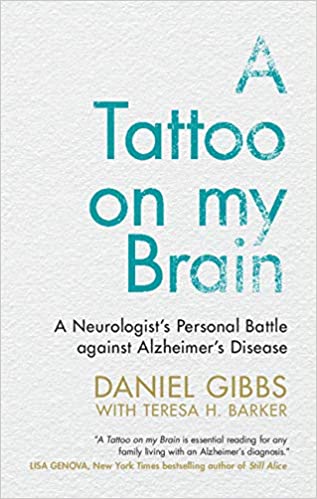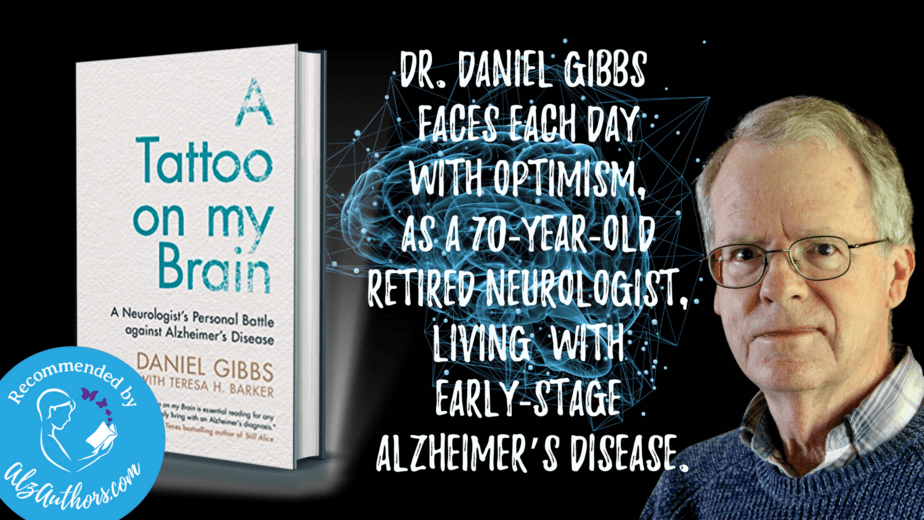 A Tattoo on my Brain
A Tattoo on my Brain
by Dr. Daniel Gibbs
I am a 70-year-old retired neurologist, and I have early-stage Alzheimer’s disease. In retrospect, my first symptom of Alzheimer’s occurred when I was 57 and realized that my sense of smell was not as sharp as it once had been. I chalked this up to normal aging, but about a year later I started to have strange, illusory odors, like the smell of baking bread mixed with perfume. They would come out of nowhere and last a few minutes to an hour or so. These are called phantosmias, and they are sometimes associated with neurodegenerative disorders. At the time I was not aware of the association of loss of smell with Alzheimer’s, but it turns out that virtually all people with the disease have at least some impairment of olfaction when tested, but most are not aware of it. I still wasn’t worried until while doing genealogical research in 2012 I unexpectedly discovered that I have two copies of the APOE-4 allele putting me at very high risk for dementia. Alzheimer’s disease had not been on my radar screen because both my parents had died in midlife from cancer. I had taken care of many patients with Alzheimer’s disease as a neurologist, but most of these, especially early in my career, had been in the late stages of the disease. I retired in 2013 at age 62 even though I did not yet have any measurable cognitive impairment.
Two years later I volunteered for my first research study, an investigation of a then new PET scan that could detect the abnormal tau protein in the neurofibrillary tangles of Alzheimer’s. I had amyloid and tau PET scans, an MRI scan, and two days of cognitive testing. The results showed that I had mild cognitive impairment (MCI), a moderate amount of amyloid throughout my brain, and the beginnings of abnormal tau in my medial temporal lobes where it first appears in Alzheimer’s disease. When the tests were repeated three years later in 2018, the cognitive tests were a little worse and the abnormal amyloid and tau had spread further throughout my brain. I had early-stage Alzheimer’s disease.
It is important to realize that although I had significant amounts of Alzheimer’s pathology in my brain, I was still doing pretty well cognitively. I was still reading over 100 books per year. I could still balance the checkbook. I did have increasing problems with remembering names and coming up with the right words to say, but I got around some of these problems by using memory tricks, mnemonics. I volunteered for another study, the phase 3 trial of aducanumab, recently approved by the FDA as Aduhelm. Unfortunately, I had severe side effects of brain swelling and bleeding after just four doses, resulting in two days of ICU management and a slow recovery over the next few months. I fully recovered with no persistent damage, except for the residual blood pigments left in my brain called hemosiderin. I call this the tattoo on my brain because they still show up as black dots on my MRI scans. This actually was the inspiration for me to start writing about my experiences with Alzheimer’s. I began with an opinion paper directed at other neurologists urging early recognition and management of Alzheimer’s (Gibbs, DM. Early Awareness of Alzheimer Disease: A Neurologist’s Personal Perspective. JAMA Neurol.2019;76(3):249. doi:10.1001/jamaneurol.2018.4910). I then expanded that into a book for lay readers, A Tattoo on my Brain: A Neurologist’s Personal Battle against Alzheimer’s Disease, that explains how it is possible to decrease the risk and slow the progression of the disease through lifestyle modifications, especially when started early. I am hopeful that new drugs will prove effective at slowing or even stopping the progression of Alzheimer’s, but I suspect that they will need to be used early in the disease, perhaps even before the start of cognitive impairment.
Bio:
After receiving his MD and PhD degrees from Emory University, Dr. Gibbs studied the interaction of the brain and endocrine organs during stress for six years as a research fellow and then assistant professor at the University of California at San Diego. He then finished his clinical training in neurology at Oregon Health & Science University and practiced and taught general neurology in Portland, Oregon for almost 25 years.
organs during stress for six years as a research fellow and then assistant professor at the University of California at San Diego. He then finished his clinical training in neurology at Oregon Health & Science University and practiced and taught general neurology in Portland, Oregon for almost 25 years.
Dr. Gibb’s blog:
https://tattooonmybrain.com



2 Responses
He is a man to be admired. He recently spoke and showed the documentary film at my retirement community. A very educational experience.
Alzheimer’s is a disease that has no real cure, So we need to learn how to live with as individuals, a families and as a society.
Thankyou for sharing your journey. I have symptoms for a few years now and recently tried to get medical help from my GP. I sat the screening test in his office and he said I tested normal. I said I had never been normal. I have had a Roll Royce brain and now I’m on a bicycle. The fact that I cope by working hard to organise my life with lists and notes to deal with my short term memory loss means I will never have access to any early treatments for dementia. I am 71. Both my parents had dementia but my dads only got really noticeable from when he was 95 until his death at 98. Thanks for your life style hints. I appreciate the inspiration of others who have shared their journeys to
Light my way here in New Zealand